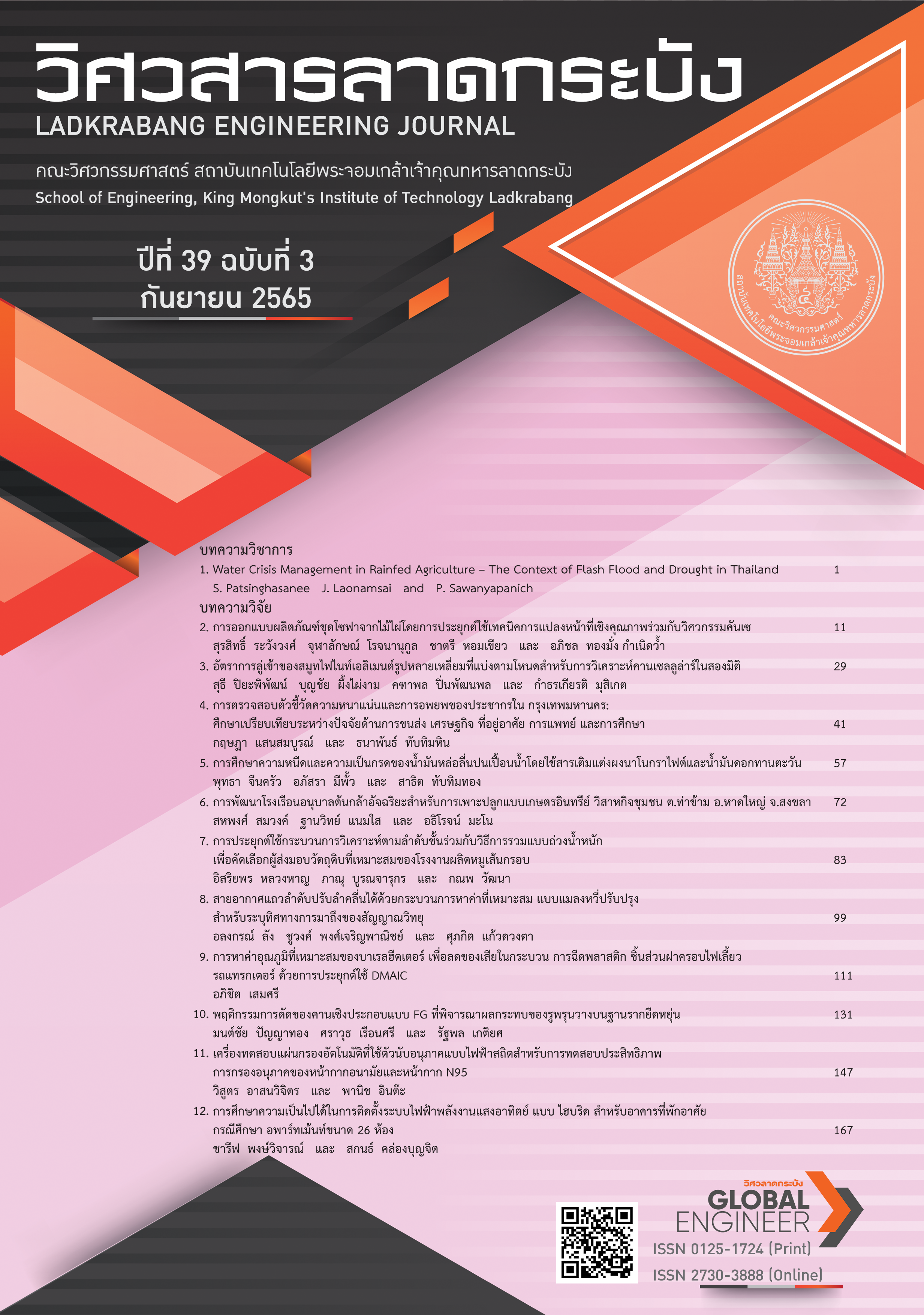สายอากาศแถวลำดับปรับลําคลื่นได้ด้วยกระบวนการหาค่าที่เหมาะสม แบบแมลงหวี่ปรับปรุงสําหรับระบุทิศทางการมาถึงของสัญญาณวิทยุ
คำสำคัญ:
สายอากาศแถวลำดับปรับลำคลื่นได้, กระบวนการหาค่าที่เหมาะสมแบบแมลงหวี่ปรับปรุง, แถวลำดับเชิงระนาบ, การระบุทิศทางการมาถึงของสัญญาณ, สายอากาศแถวลำดับแบบแพทช์บทคัดย่อ
บทความนี้นำเสนอสายอากาศแถวลำดับปรับลำคลื่นได้เพื่อใช้สำหรับการระบุทิศทางการมาถึงของสัญญาณวิทยุในช่วงความถี่ 2.4–2.5 GHz สำหรับแก้ไขปัญหาการรบกวนของสัญญาณวิทยุในโครงข่ายท้องถิ่นไร้สายโดยจะใช้สายอากาศแถวลำดับปรับลำคลื่นร่วมกับกระบวนการหาค่าที่เหมาะสมแบบแมลงหวี่ปรับปรุงในการช่วยระบุทิศทางที่มีสัญญาณแรงที่สุด สายอากาศแถวลำดับปรับลำคลื่นที่ได้นำเสนอประกอบด้วย สายอากาศไมโครสตริปแผ่นสี่เหลี่ยมวางเรียงกันเป็นแถวลำดับเชิงระนาบจำนวน 4 องค์ประกอบ วงจรเลื่อนเฟสแบบดิจิตอล ตัวเชื่อมต่อแบบมีทิศทาง และไมโครคอนโทรลเลอร์ ซึ่งกระบวนการพิจารณาทิศทางและการปรับลำคลื่นหลักของสายอากาศจะถูกควบคุมด้วยกระบวนการหาค่าที่เหมาะสมภายในตัวไมโครคอนโทรลเลอร์ จากผลการจำลองของสายอากาศแถวลำดับเชิงระนาบพบว่า สามารถปรับเปลี่ยนทิศทางของลำคลื่นหลักที่มีความกว้างลำคลื่นเท่ากับ 30 องศา ได้ในระนาบมุมกวาดและระนาบมุมยก ด้วยการปรับความต่างเฟสของสัญญาณของแต่ละองค์ประกอบย่อย จากผลการสร้างและทดสอบพบว่าสายอากาศต้นแบบสามารถปรับลำคลื่นได้สอดคล้องกับผลการจำลองและเมื่อใช้งานร่วมกับกระบวนการหาค่าที่เหมาะสมในการระบุทิศทางของสัญญาณวิทยุสามารถเพิ่มประสิทธิภาพการทำงานของสายอากาศได้
References
P. K. Tiwary, N. Maskey, S. Khakurel and G. Sachdeva, “Effects of Co-channel Interference in WLAN and Cognitive Radio Based Approach to Minimize It,” in 2010 International Conference on Advances in Recent Technologies in Communication and Computing, Kottayam, India, 2010, pp. 158–160, doi: 10.1109/ARTCom.2010.57.
M. Yang, D. Kaffes, D. Mavrakis and S. Stavrou, “The Impact of Environment Variation on Co-channel Interference in WLAN,” Twelfth International Conference on Antennas and Propagation, 2003 (ICAP 2003), Exeter, UK, 2003, pp. 71–75, doi: 10.1049/cp:20030018.
J. Zhang, G. Han and Y.Qian, “Queuing Theory Based Co-Channel Interference Analysis Approach for High-Density Wireless Local Area Networks,” Sensors, vol 16, no. 9, 2016, Art. no. 1348, doi: 10.3390/s16091348.
H. Furukawa, Y. Kamio and H. Sasaoka, “Cochannel Interference Reduction and Path-diversity Reception Technique Using CMA Adaptive Array Antenna in Digital Land Mobile Communications,” IEEE Transactions on Vehicular Technology, vol. 50, no. 2, pp.605–616, 2001, doi: 10.1109/25.923072.
B. R. Petersen and D. D. Falconer, “Suppression of Adjacent-channel, Co-channel, and Intersymbol Interference by Equalizers and Linear Combiners,” IEEE Transactions on Communications, vol. 42, no. 12, pp. 3109–3118, 1994, doi: 10.1109/26.339831.
P. Denisowski and P. Busch, “Interference hunting tools,” in An Introduction to Interference Hunting, Columbia, MD, USA: Rohde & Schwarz white paper, 2014, ch. 2, sec. 2, pp. 8–10.
J. Duplouy, “Wideband Reconfigurable Vector Antenna for 3-D Direction Finding Application,” Ph.D. Thesis, Dept. Electromagnetism and High Frequency Systems, Univ. de Toulouse, Toulouse, France, 2019.
C. A. W. Vale, “Variations on Loop and Adcock Array Topologies for Improved Radio Direction Finding Performance,” in 2012 IEEE-APS Topical Conference on Antennas and Propagation in Wireless Communications (APWC), Cape Town, South Africa, 2012, pp. 997–1000, doi: 10.1109/APWC.2012.6324979.
M. A. Tinati and S. Bayati, “Designing of an Adaptive Adcock Array and Reducing the Effects of Other Transmitters, Unwanted Reflections and Noise,” in 2006 IEEE Conference on Cybernetics and Intelligent Systems, Bangkok, Thailand, 2006, pp. 1–4, doi: 10.1109/ICCIS.2006.252350.
R. Mueller and R. Lorch, “Application of Modern DOA Algorithms to an Adcock Array Antenna,” in The 8th European Conference on Antennas and Propagation (EuCAP 2014), The Hague, Netherlands, 2014, pp. 2215–2218, doi: 10.1109/EuCAP.2014.6902250.
D. N. Aloi and M. S. Sharawi, “Modeling and Validation of a 915MHz Single Channel Pseudo Doppler Direction Finding System for Vehicle Applications,” in 2009 IEEE 70th Vehicular Technology Conference Fall, Anchorage, AK, USA, 2009, pp. 1–5, doi: 10.1109/VETECF.2009.5378802.
A. Xiaobo, F. Zhenghe, W. weidong and T. Li, “A Single Channel Correlative Interferometer Direction Finder Using VXI Receiver,” in 2002 3rd International Conference on Microwave and Millimeter Wave Technology, 2002. Proceedings. ICMMT 2002., Beijing, China, 2002, pp. 1158–1161, doi: 10.1109/ICMMT.2002.1187913.
H. SengüL, A. E. Gürel and A. Orduyilmaz, “Passive Direction Finding Using Correlative Interferometer,” in 2021 29th Signal Processing and Communications Applications Conference (SIU), Istanbul, Turkey, 2021, pp. 1–4, doi:10.1109/SIU53274.2021.9477965.
G. -P. Gao, B. Hu and J. -S. Zhang, "Design of a Miniaturization Printed Circular-Slot UWB Antenna by the Half-Cutting Method,” in IEEE Antennas and Wireless Propagation Letters, vol. 12, pp. 567–570, 2013, doi: 10.1109/LAWP.2013.2259790.
J. Huang and V. Jamnejad, “A microstrip array feed for land mobile satellite reflector antennas,” IEEE Transactions on Antennas and Propagation, vol. 37, no. 2, pp. 153–158, 1989, doi: 10.1109/8.18701.
M. Krairiksh, P. Ngamjanyaporn and C. Kessuwan, “A Flat Four-Beam Compact Phased Array Antenna,” IEEE Microwave and Wireless Components Letters, vol. 12, no. 5, pp. 184–186, 2002, doi: 10.1109/7260.1000197.
A. Buffi, A. A. Serra, P. Nepa, H-. T. Chou and G. Manara, “A Focused Planar Microstrip Array for 2.4 GHz RFID Readers,” IEEE Transactions on Antennas and Propagation, vol. 58, no. 5, pp. 1536–1544, 2010, doi: 10.1109/TAP.2010.2044331.
S. Loya and H. Khan, “An Efficient Microstrip Planar Array For Evaluating Channel Capacity Of Massive MIMO Systems,” in 2021 2nd International Conference on Range Technology (ICORT), Balasore, India, 2021, pp. 1–6, doi:10.1109/ICORT52730.2021.9581885.
Q. X. Lai, Y. M. Pan, S. Y. Zheng and W. J. Yang, “Mutual Coupling Reduction in MIMO Microstrip Patch Array Using TM10 and TM02 Modes,” IEEE Transactions on Antennas and Propagation, vol. 69, no. 11, pp. 7562–7571, 2021, doi: 10.1109/TAP.2021.3090520.
R. Kawdungta, S. Kawdungta, D. Torrungrueng and C. Phongcharoenpanich, “Switched Beam Multi-Element Circular Array Antenna Schemes for 2D Single-Anchor Indoor Positioning Applications,” IEEE Access, vol. 9, pp. 58882–58892, 2021, doi:10.1109/ACCESS.2021.3072951.
S. Kawdungta and C. Phongcharoen-panich, “MFOA - integrated Modifed Inverted F-based Adaptive Array Antenna for 2.4 GHz Band Applications,” International Journal of RF and Microwave Computer Aided Engineering, vol. 26, no. 9, pp. 784–795, 2016, doi: 10.1002/mmce.21030.
S. Kawdungta, D. Torrungrueng, A. Lang and C. Phongcharoenpanich, “Design of Antenna Arrays by Using Modified Fruit Fly Optimization Algorithm,” in 2021 18th International Conference on Electrical Engineering/Electronics, Computer, Telecommunications and Information Technology (ECTI-CON), Chiang mai, Thailand, 2021, pp. 69–72, doi: 10.1109/ECTI-CON51831.2021.9454774.
M. Mhudtongon, C. Phongcharoenpanich, and S. Kawdungta, “Modified Fruit Fly Optimization Algorithm for Analysis of Large Antenna Array,” International Journal of Antennas and Propagation, vol. 2015, 2015, Art. no. 124675, doi: 10.1155/2015/124675.
K. Wong, “Compact Microstrip Antennas,” in Compact and Broadband Microstrip Antennas, Cullompton, United Kingdom: John Wiley & Sons., 2002, ch. 2, sec. 2, pp. 23–26.
Macom Technologies, “Digital Phase Shifter 4-Bit, 2.3 - 3.8 GHz,” MAPS-010144 Data Sheet, November. 2010.
E. J. Wilkinson, “An N-Way Hybrid Power Divider,” IRE Transactions on Microwave Theory and Techniques, vol. 8, no. 1, pp. 116–118, 1960, doi: 10.1109/TMTT.1960.1124668.
Analog Devices, “Log Detector Controller,” AD8317 Data Sheet, 2019.
Arduino, “Arduino UNO R3,” Product Reference Manual, Dec. 2021.
Downloads
เผยแพร่แล้ว
How to Cite
ฉบับ
บท
License
Copyright (c) 2022 คณะวิศวกรรมศาสตร์ สถาบันเทคโนโลยีพระจอมเกล้าเจ้าคุณทหาร

This work is licensed under a Creative Commons Attribution-NonCommercial-NoDerivatives 4.0 International License.
บทความที่ได้รับการตีพิมพ์เป็นลิขสิทธิ์ของคณะวิศวกรรมศาสตร์ สถาบันเทคโนโลยีพระจอมเกล้าเจ้าคุณทหารลาดกระบัง
ข้อความที่ปรากฏในบทความแต่ละเรื่องในวารสารวิชาการเล่มนี้เป็นความคิดเห็นส่วนตัวของผู้เขียนแต่ละท่านไม่เกี่ยวข้องกับสถาบันเทคโนโลยีพระจอมเกล้าเจ้าคุณทหารลาดกระบัง และคณาจารย์ท่านอื่นๆในสถาบันฯ แต่อย่างใด ความรับผิดชอบองค์ประกอบทั้งหมดของบทความแต่ละเรื่องเป็นของผู้เขียนแต่ละท่าน หากมีความผิดพลาดใดๆ ผู้เขียนแต่ละท่านจะรับผิดชอบบทความของตนเองแต่ผู้เดียว






